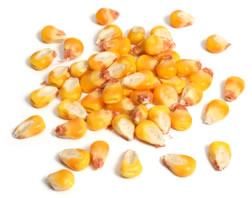Recently, I came across some people storing large amounts of corn without fully understanding the vitamin deficiencies that can result in pellagra. They have some 55-gallon barrels in their storage and are planning on using corn as a main staple. This was based on their understanding that it was commonly used in the South and by many of the Native Americans as a staple in their diet. As a result, I have decided to reprint a post I put up several years ago on this subject.
Treating Corn to Prevent Pellagra
In yesterday’s post, I mentioned corn and pellagra. Pellagra was a vitamin deficiency disease caused by a lack of niacin. It became an epidemic in the south during the great depression. Corn was a main staple eaten by many of the poor.
When corn was first introduced into non-Native American farming, it was generally welcomed with enthusiasm for its productivity. However, a widespread problem of malnutrition soon arose wherever corn became the main staple. This was a mystery since these types of malnutrition were not normally seen among the Native Americans to whom corn was the principal staple food.
It was eventually discovered that the Native Americans learned long ago to add alkali—in the form of wood ashes among North Americans and lime (calcium carbonate) among South and Central Americans—to corn meal. This liberates the B-vitamin niacin, the lack of which was the underlying cause of the condition known as pellagra. This is known as Nixtamalization and corrects the niacin deficiency.
Pellagra seldom occurs among people who eat corn in moderation . The soaking of the corn used to make the tortillas increases the availability of the niacin. Masa Harina which is sold in many Mexican stores is corn meal treated with lime. The lime that corn for tortillas are soaked in is “Calcium Hydroxide” or “Pickling Lime”…not lime juice. Hominy is another process that treats corn with lye (alkali) and liberates the niacin.
. The soaking of the corn used to make the tortillas increases the availability of the niacin. Masa Harina which is sold in many Mexican stores is corn meal treated with lime. The lime that corn for tortillas are soaked in is “Calcium Hydroxide” or “Pickling Lime”…not lime juice. Hominy is another process that treats corn with lye (alkali) and liberates the niacin.
Besides the lack of niacin, pellagra was also characterized by protein deficiency, the result of a lack of two key amino acids in corn, lysine and tryptophan. The Native Americans had learned to balance their consumption of corn with beans and other protein sources, such as meat and fish, in order to acquire the complete range of amino acids for normal protein synthesis.
Corn, despite its limitations, is still an excellent storage food. The best variety to store is yellow flint or dent corn. They are low in moisture if properly dried. They make good polenta meal and flour. Popcorn should not be ground in most mills due to its extreme hardness. Several mills such as The Family Grain Mill and the Back T Basic Mill recommend that their mills not be used for popcorn.
This is a good example of why you would want a good variety in your food storage. I will try to publish recipes for making tortillas and hominy the old-fashioned way in the next few days.
Howard


Can you give a step by step explanation of how lime is added and the steps to making it edible again?
I knew the historical facts, but never thought about how to fix the problem.
THANX FOR THIS ARTICLE ABOUT STORING CORN . I HAVE SOME CRACKED CORN IN STORAGE.. WILL THIS ALSO BE A PROBLEM ? THANK YOU, ANOTHER ,VERY, INTERESTING POST .
I remember stories about, and reading about, making lye. It was only recently that I realized that this was the same lye used to make soap.
Would dearly love to learn to safely make and use lye.
How do you treat corn with it?